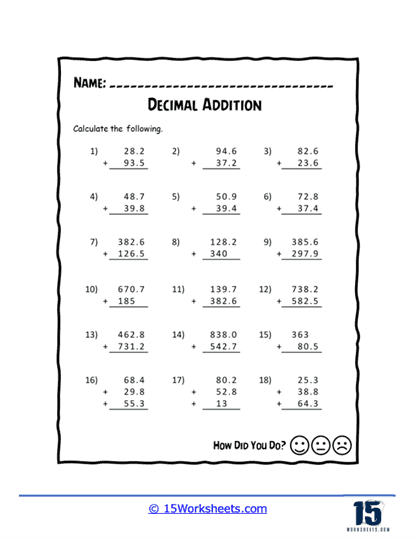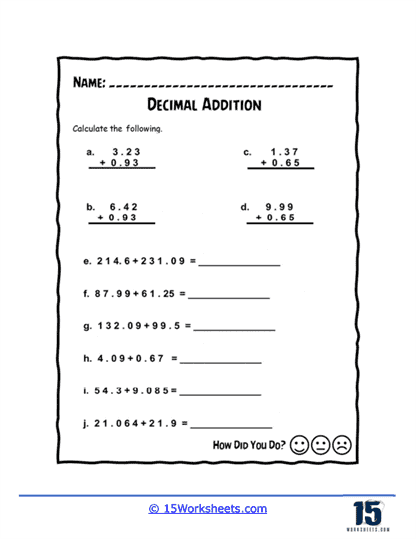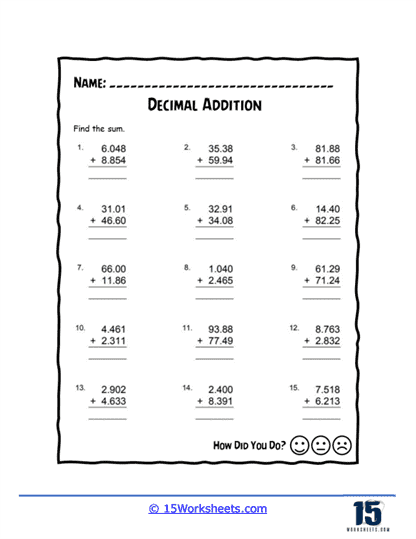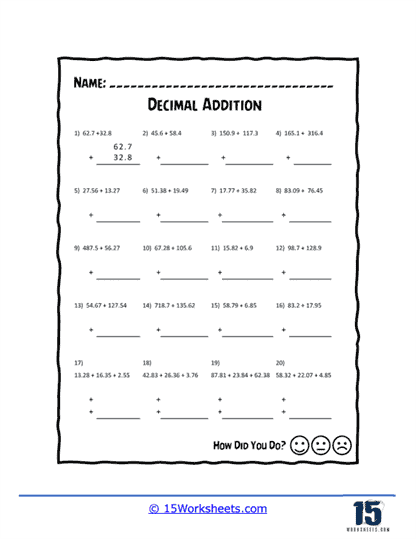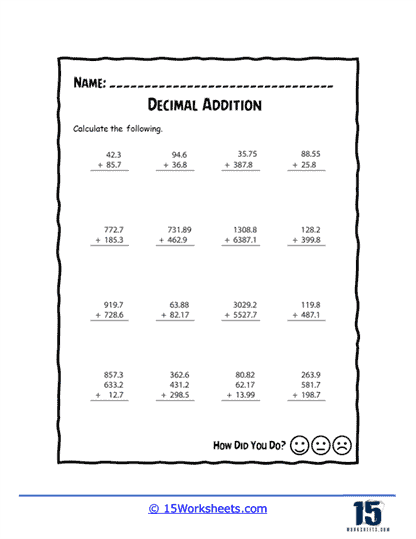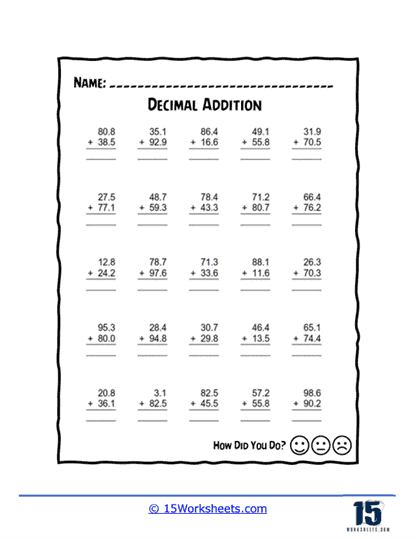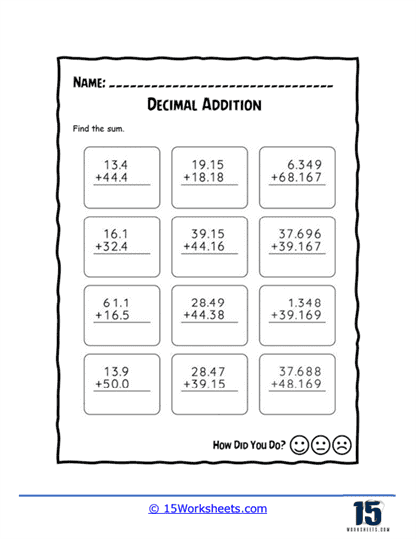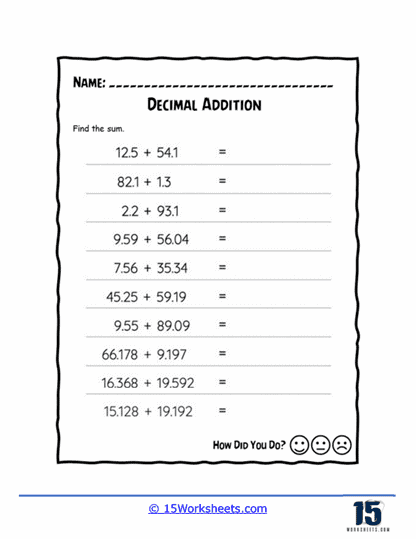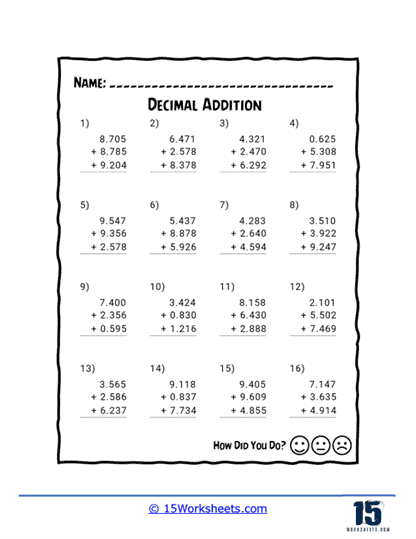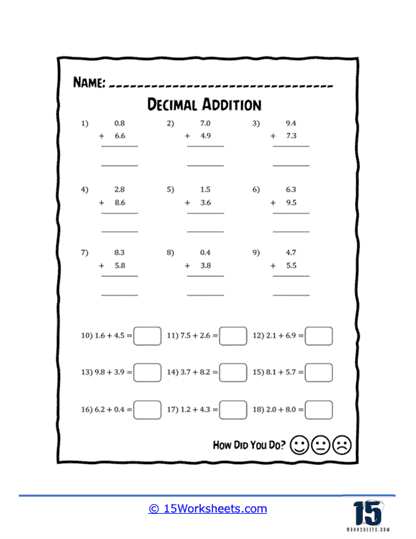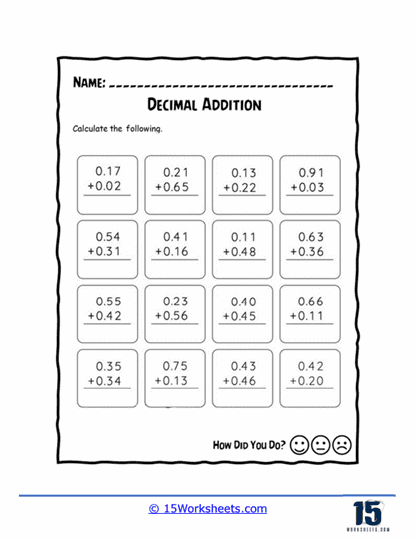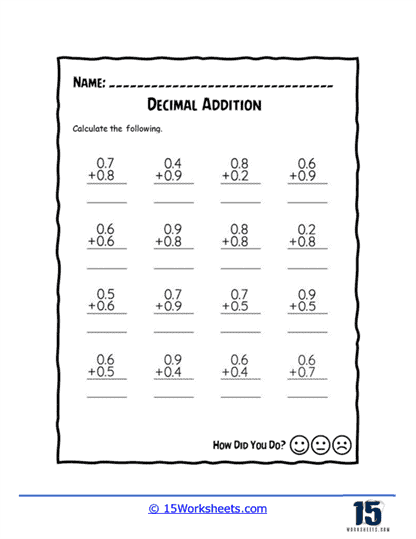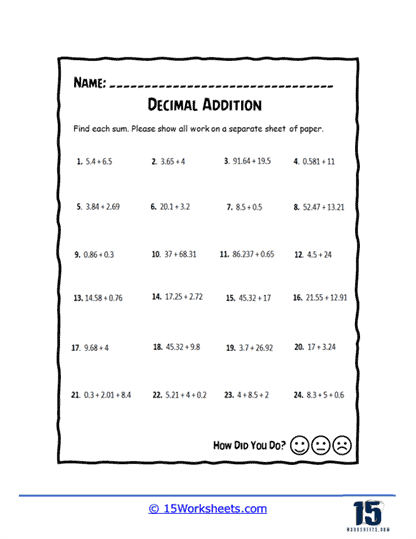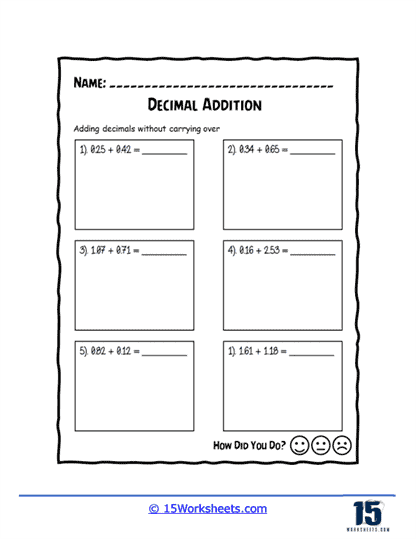Decimal Addition Worksheets
All About These 15 Worksheets
These Decimal Addition worksheets are designed to help students master the concept of adding decimal numbers. The worksheets include a variety of creative and engaging exercises to help students build their skills and confidence in decimal addition.
Each worksheet in the series includes a mix of problems with varying degrees of difficulty, designed to challenge and engage students at different skill levels. The problems require students to add decimal numbers with different numbers of decimal places and to carry over decimals when necessary.
This series is most suitable for students in grades 5 to 7. It can be used in the classroom as a supplement to the math curriculum or at home as a way for parents to help their children practice and reinforce their math skills.
A Look At Individual Worksheets
Kicking things off, we’ve got Vertical Decimal Addition and Vertical and Horizontal Decimal Sums-a charmingly misleading warm-up that tricks students into thinking decimals are just whole numbers in disguise. The vertical problems are like polite citizens forming an orderly queue, while the horizontal ones come in sideways like rebellious teenagers testing your lining-up skills.
Then come the alignment assassins: Lining Up Thousandths and Positioning Decimal Sums. These worksheets don’t care how fast you add; they care where you add. “Mind the decimal!” becomes your new mantra as you awkwardly squint at each number like you’re reading microfilm. It’s a zen exercise in place value mindfulness. In Hundreds Addition, you start to question how many digits are too many digits, and in Fast Paced Sums, there’s no time to panic-only time to channel your inner math ninja before the decimal points stage a coup.
Just when you thought it was safe to return to sanity, Growing Decimals sneak in with numbers expanding faster than a balloon at a birthday party. Each sum feels like a game of “spot the invisible tenths.” Then, Vertical Decimal Sums returns-like a math sequel you didn’t ask for but secretly enjoy-to reinforce that vertical stacking is the key to keeping the decimal realm from falling into chaos. Things heat up in Adding 3 Decimal Sums, because now it’s a decimal throuple and you’re responsible for making it work. Therapy not included.
Two Way Decimal Addition adds a delightful twist: dual paths to potential success or total disaster. Meanwhile, Tenth and Hundredth Place Addition and Tenths Place Addition are the nit-picky roommates of the worksheet universe-always reminding you that yes, the difference between 0.1 and 0.01 absolutely matters. If you’re tempted to round anything early, these sheets will shame you into humility with a red pen and a broken dream.
Finally, there’s a dramatic finale: Sums of Decimals & Whole Numbers, Carry Over Decimals, and the ever-dreaded Decimal Addition Word Problems. Here is where students become decimal gladiators. Adding whole numbers and decimals? That’s like combining tea and coffee-possible, but unsettling. Carrying over decimal values forces you to think three steps ahead, like a math-playing chess master. And the word problems? They’re where decimals go to test your reading comprehension, logic, and patience-all at once. It’s decimal math meets literary analysis, and it’s the showdown we never knew we needed.
In the end, these worksheets aren’t just about getting the right answers-they’re about embracing the beautiful, absurd, and sometimes infuriating journey of decimal addition. They’ll sharpen your skills, expand your brain, and probably make you whisper “0.01 plus 0.09 equals 0.10” in your sleep. And really, isn’t that the dream?
How to Add Decimal Values
Adding decimal values is similar to adding whole numbers, with the added step of aligning decimal points. Here’s a step-by-step guide to adding decimal values that teachers can share with their students:
- Align Decimal Points – Write the numbers vertically so that the decimal points line up with each other. This makes it easier to add digits in the same place value.
- Add Zeros, if Necessary – If one decimal has more digits after the decimal point than the other, add zeros to the shorter decimal so that they have the same number of digits. This will make adding the decimals simpler. Remember that adding zeros to the right of a decimal number does not change its value.
- Start Adding From the Rightmost Digit – Begin with the rightmost digits (the smallest place value) and add them together. If the sum is 10 or greater, carry the 1 to the next place value on the left.
- Continue Adding Digits – Continue adding the digits in each place value from right to left, carrying any value of 10 or greater to the next place value on the left.
- Place the Decimal Point – Once you have added all the digits, place the decimal point in the sum directly below the aligned decimal points of the numbers being added.
- Simplify, if Necessary – If the sum has trailing zeros after the decimal point (e.g., 4.50), you can remove them to simplify the result (e.g., 4.5).
Here’s an example of adding 3.25 and 0.879:
Step 1: Align decimal points 
Step 2: Add zeros, if necessary 
Start adding from the rightmost digit: 9 (0+9)
Step 3: Continue adding digits 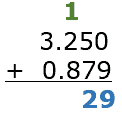
12 (5+7, carry the 1)
Step 4: 11 (1 + 2 + 8, carry the 1) 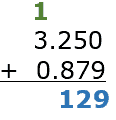
Step 5: Place the decimal point 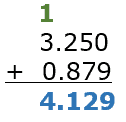
Simplify, if necessary: No trailing zeros in this case, so the sum remains 4.129.
The sum of 3.25 and 0.879 is 4.129.

